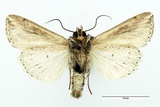Mythimna l-album (Linnaeus, 1767) Species
Last modified: Nov. 19, 2025, 7:45 p.m.
Used to be a rare immigrant in the early days but is now a part of our local fauna. This areal expansion is probably due to climate change. Since about 2008 it has been a fairly common species throughout Belgium.
This species is considered Least Concern according to the IUCN Red List category for Flanders 2023.
Details
- Classification
- Family: Noctuidae > Subfamily: Hadeninae > Tribus: Hadenini > Genus: Mythimna > Subgenus: Hyphilare > Species: Mythimna l-album
- Vernacular names
- Witte-l-uil (NL), L-album Wainscot (EN), Le L blanc (FR), Weißes L (DE)
- First mention in Belgium
- De Sélys-Longchamps E. 1844. Énumération des insectes Lépidoptères de la Belgique. — Mémoires de la Société royale des Sciences de Liége 2: 1–35. On page 12. view page
- Status
-
Native
Distribution
Bionomics
Hibernates as a first instar larva and pupates in a cocoon underground.
The adults come to light in small numbers and are easily attracted to sugar.
Flight periods
The adults fly in two generations a year from late May till beginning of November, but most specimens are observed during September.
Observed on
- Host plant (species):
- Ammophila arenaria and Phalaris arundinacea
- Substrates:
- Grasses
The larva lives on various species of Graminae, but mainly on Ammophila arenaria or Phalaris arundinacae.








